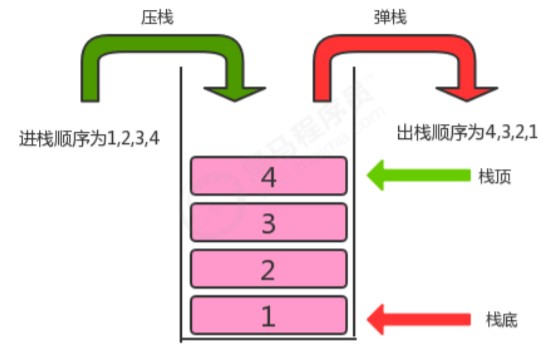一、 栈概述
- 栈是将生活中的场景引入计算机中概念,古代的客栈,供旅客休息进出,我们把休息的过程作为数据的存储过程,进出作为数据的增删,于是有了线性表的另一种结构——栈。
- 栈是一种先进后出(FILO)的数据结构,是只能在一端进行数据插入和删除的线性表,按照先进后出的原则存储数据。
- 首先进入的数据被压到栈底,称为压栈,后进入的数据存放在栈顶,称为弹栈。需要读数据的时候则从栈顶一个一个的弹出数据元素。

二、 栈实现
|
import java.util.Iterator; import com.data.struct.common.list.link.Node; public class Stack<T> implements Iterable<T> {
// 结点声明 public Node head;
// 栈的深度 public int N;
public Stack() { head = new Node<T>(null,null); N=0; }
/** * 栈是否为空 * @return */ public boolean isEmpty() { return N==0; }
/** * 压栈 * @param t */ public void push(T t) { //头结点连接的结点 Node firstNode = head.next;
//新建指向头结点连接的原结点 Node newNode = new Node<T>(t,firstNode);
//头结点指向新结点 head.next = newNode;
N++; }
/** * 弹栈 * @param t */ public T pop(T t) {
if(isEmpty()) { return null; }
//头结点连接的结点 Node firstNode = head.next;
//头结点连接的新结点 Node newFirstNode = firstNode.next;
head.next = newFirstNode;
N--;
return (T) firstNode.item; }
/** * 栈的深度 * @return */ public int size() { return N; } @Override public Iterator<T> iterator() { return new MyIterator(); } public class MyIterator implements Iterator<T> { Node node;
public MyIterator() { node = head; } @Override public boolean hasNext() { return node.next != null; } @Override public T next() { return (T) node.next.item; } } } |
三、 队列概述
队列是一种先进先出(FIFO)的数据结构,是一种在一端插入,在另一端删除的线性表结构,按照先进先出的原则存储数据元素。

四、 队列实现
|
public class Queue<T> implements Iterable<T>{
//声明头结点 public Node head;
//声明尾结点 public Node last;
//队列大小 public int N; public Queue() { head = new Node<T>(null, null); last = null; N=0; }
/** * 队列大小 * @return */ public int size() { return N; }
/** * 队列是否为空 * @return */ public boolean isEmpty() { return N==0; }
/** * 元素进队列 * @param t */ public void enqueue(T t) { if(last==null) { last = new Node<T>(t, null); head.next = last; }else { Node oldLast = last; last = new Node<T>(t, null); oldLast.next = last; }
N++; }
/** * 元素出队列 * @return */ public T dequeue() { if(isEmpty()) { return null; }
Node firstNode = head.next; Node newFirstNode = firstNode.next; head.next = newFirstNode;
N--;
if(isEmpty()) { last = null; }
return (T) firstNode.item; } @Override public Iterator<T> iterator() { return new MyIterator(); }
public class MyIterator implements Iterator<T> { Node node = null;
public MyIterator() { node = head; } @Override public boolean hasNext() { return node.next != null; } @Override public T next() { Node nextNode = node.next; node = node.next; return (T) nextNode.item; } } } |